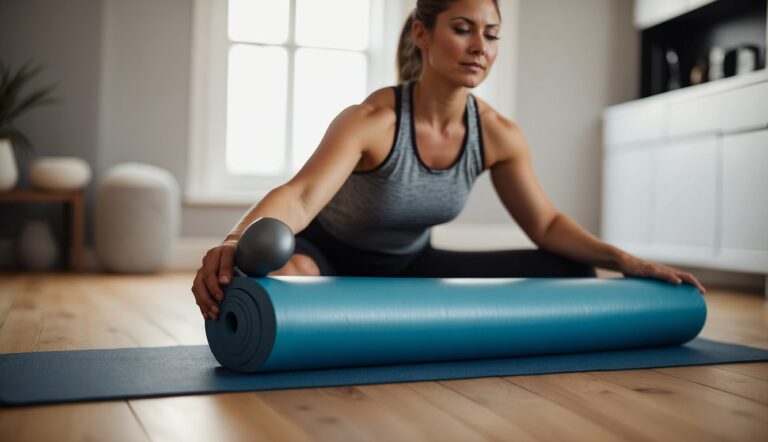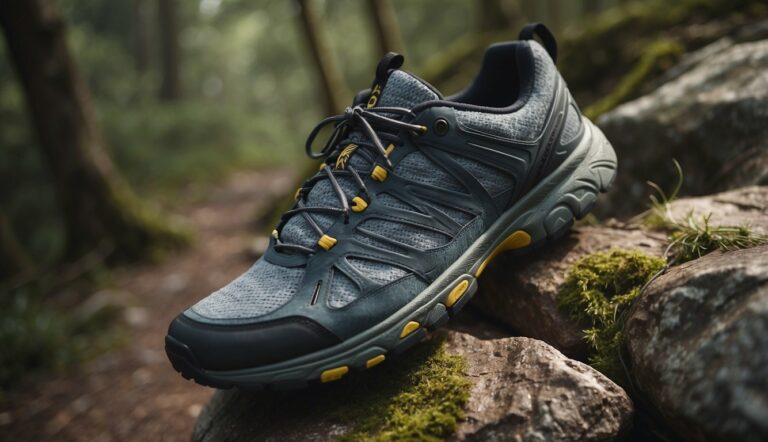The Impact of Trail Running on Joint Health: Strategies for Knee, Ankle, and Hip Protection
Trail running offers a unique exercise experience, blending the cardiovascular benefits of running with the physical challenges of varied terrain. As a UESCA certified running coach, I am well-versed in the effects of trail running on joint health. Properly managing the impact on your knees, ankles, and hips is crucial for both immediate performance and long-term well-being.
Navigating uneven surfaces gives joints a thorough workout but also increases the risk of injury if not approached with care. To protect against potential damage, runners should focus on strengthening the muscles that support their joints. Building stability through targeted exercises will help cushion and support your knees, ankles, and hips during trail runs.
Maintaining joint health is a balancing act of staying active and avoiding overuse. Integrating cross-training activities and ensuring you have adequate rest between runs can preserve your joints. As a runner myself, I advocate for listening to your body’s signals and adjusting your training regimen to include a variety of low-impact exercises that promote joint longevity without sacrificing the enjoyment of the trail.
Joint Health for Trail Runners – Common Problems
Joints are the functional units of the musculoskeletal system, allowing us to walk, run, and move freely. As a UESCA certified running coach, I guide runners through practices that support joint health, especially when trail running. Joints like the knees, ankles, and hips come under significant strain during running owing to repetitive impact.
Cartilage and synovial fluid are crucial to joint health. Cartilage, a flexible tissue, cushions the ends of bones within joints. Synovial fluid, produced by the synovial membrane, lubricates the joints, reducing friction and wear-and-tear during movement.
Inflammation and joint pain are common symptoms that can arise from stress on joints. Consistent impact can contribute to joint degeneration, potentially leading to osteoarthritis, characterized by the breakdown of articular cartilage and formation of bone spurs.

To maintain joint health, focusing on proper technique and support is vital. Here’s how runners can protect their joints:
- Warm-up: Engage in dynamic stretching to prepare joints.
- Footwear: Wear shoes providing suitable cushioning and support.
- Strength Training: Build muscles around joints to improve stability.
- Rest: Allow sufficient recovery time between runs to let joints repair.
Remember, while trail running can be demanding on the joints, adopting good habits can help in maintaining their health and functionality.
Biomechanics of Running
Understanding the biomechanics of running is crucial to protect joints like knees, ankles, and hips while optimizing performance. Let’s dive into what’s important for maintaining proper running form, navigating different terrains, and choosing the right footwear and orthotics.
Running Form
My experience tells me that proper running form is essential to prevent injury and improve efficiency. Stride rate and running pace influence the load on your joints. By maintaining a higher stride rate with a comfortable pace, you can reduce the impact on your knees and hips. It’s all about smooth motions, with your body leaning slightly forward, and a midfoot strike that aligns under your center of gravity.
Impact of Different Terrains
When running on varying terrains, the demands on your biomechanics shift. Soft trails can decrease stress on your ankles and knees, while uneven surfaces can challenge your balance and stability. Keep your steps light and adapt your stride to the terrain; for rocky trails, for instance, a shorter and more cautious stride will help protect your joints.
Footwear and Orthotics
The choice of running shoes and the use of orthotics can have a profound impact on your joint health. Shoes must provide proper support and suit the terrain you’re running on. Here’s a summarized table for selecting footwear:
| Terrain Type | Footwear Feature |
|---|---|
| Road | Cushioned Sole |
| Trail | Robust Tread |
| Mixed | Versatile Design |
For people with specific biomechanical needs, orthotics can be a game-changer. These devices correct foot alignment, which in turn can alleviate undue stress on ankles, knees, and hips. Always opt for custom-fitted orthotics as they are tailored to your feet and running style.
Injury Prevention Strategies
Reducing the risk of knee, ankle, and hip injuries is paramount for long-term joint health in trail running. I’ll cover essential aspects such as strength training, flexibility and stretching, and cross-training to safeguard your joints.
Strength Training
Key exercises for trail runners:
- Hamstrings: Leg curls and deadlifts help in preventing muscle imbalances.
- Quadriceps: Squats and lunges maintain stability for knee joints.
- Calf Muscles: Heel raises prevent common overuse injuries like Achilles tendonitis.
To prevent knee injuries and other damage, it’s crucial to build a strong muscular foundation that supports your joints during the variable terrain of trail running.
Flexibility and Stretching
Daily stretches are vital for joint health:
- Hamstrings: Standing or seated stretches improve flexibility.
- Quadriceps: Lying or standing pulls reduce the risk of knee injuries.
- Calves: Wall stretches help in mitigating the chances of ankle sprains and bunion pain.
Incorporating yoga into your routine enhances overall flexibility, reduces muscle tightness, and can help prevent the trauma of unexpected turns and slips on the trail.
Cross-Training
Low-impact activities for balanced fitness:
- Swimming: Builds aerobic capacity without adding stress to the joints.
- Cycling: Strengthens leg muscles and offers a break from the impact of running.
- Rowing: Provides a full-body workout that adds core strength and endurance.
Including these activities in your training plan can reduce muscle weakness and give overworked joints from running a much-needed break.
Recovery and Rehabilitation

Recovery and rehabilitation are crucial for maintaining joint health and returning to trail running without persistent issues. Timely and appropriate treatment of injuries, coupled with strategies for rest and nutrition, support a runner’s return to the trails.
Physical Therapy
Physical therapy is a strategic approach to recovering from running injuries. I recommend exercises that focus on strengthening the muscles surrounding the knee, ankle, and hip to provide better support and stability. Here’s a sample exercise routine:
- Side leg raises: 2 sets of 15 reps per side
- Clamshells: 2 sets of 15 reps per side
- Hip bridges: 2 sets of 15 reps
A physical therapist can provide tailored exercises and treatment plans to address specific injuries and correct biomechanical imbalances.
Nutrition and Supplements
Adequate nutrition speeds up recovery. It’s essential to eat a balanced diet rich in protein and omega-3 fatty acids to aid in the repair of tissues. Including supplements like glucosamine and chondroitin may contribute to joint health by providing the building blocks for cartilage.
Supplements Recommended for Joint Health:
| Supplement | Suggested Benefit |
|---|---|
| Glucosamine | May help rebuild cartilage |
| Chondroitin | Often used to combat joint pain and inflammation |
Rest and Recovery
Rest isn’t about inactivity; it’s about allowing your body to heal. I advise using ice to reduce swelling and pain post-injury. Incorporating days off into your training schedule ensures you don’t over-train, which is essential for preventing overuse injuries. Sleep also plays a vital role in recovery, aiming for 7-9 hours per night.
- Ice injured joints for 20 minutes several times a day.
- Incorporate at least one full rest day per week into your training regimen.
- Ensure sufficient sleep to promote healing.
Managing Running with Pre-Existing Joint Conditions

As a UESCA certified running coach, I’ve worked with athletes who have various joint conditions. It’s crucial to adapt running practices and seek medical guidance to safely engage in physical activity. Here’s how you can manage running with joint conditions like arthritis or runner’s knee effectively.
Adapting Running Practices
Running Form: Good form minimizes stress on the joints. I always emphasize the importance of proper running form, which includes maintaining a short, quick stride and avoiding overstriding. Aim for a stride rate of around 160-180 foot strikes per minute, which can be tracked with a metronome app or device.
Strength Training: Strengthening the muscles around your knees, ankles, and hips can help take pressure off the joints. Here’s a simple exercise for knee strength:
- Step-Ups: Stand a foot in front of a bench or step. Step up with one foot, followed by the other, and then step down in the reverse order. Aim for 3 sets of 10-15 reps on each leg.
Pacing: If you have a joint condition, avoid overexerting. Start with shorter, less intense runs and gradually increase as tolerated.
Surface Selection: Run on softer surfaces, like tracks or trails, that are gentler on the joints compared to hard pavement.
Medical Consultation
Before starting or continuing with a running regimen, consult with a healthcare professional if you have a pre-existing joint condition. Here’s what to keep in mind:
- Orthopedic Surgeon: For those with more serious conditions such as severe osteoarthritis, an assessment from an orthopedic surgeon may be necessary.
- Personal Trainers: A certified trainer can work with you to create a personalized training program that takes your joint health into account.
- University of California, San Francisco: Research from institutions like UCSF can provide insights into managing physical activity with joint conditions.
It’s also important to understand the role of genetics and consider that inactivity can contribute to joint problems and obesity, which may exacerbate joint pain. Aim for a balance that includes running without exacerbating your condition.
Long-Term Joint Health and Lifestyle Choices
Protecting your joints during trail running involves a comprehensive approach that extends beyond the activity itself. Long-term joint health hinges on regular, balanced physical activity and the maintenance of a healthy body weight.
Balanced Exercise Regimen
In my experience, incorporating a variety of exercises into your routine is crucial for supporting joint health. It’s not just about running; it’s also about building the muscle strength and bone density that cushion and protect your joints. Incorporate these activities weekly:
- Strength Training: 2-3 times to support joint stability.
- Low-Impact Cardio: Such as swimming or cycling, for endurance without excessive joint strain.
- Flexibility Exercises: Including yoga or stretching daily to maintain joint range of motion.
A balanced regimen can reduce the incidence of arthritis and other signs of joint wear, particularly in the knees, ankles, and hips commonly affected by long-distance running.
Maintaining Healthy Body Weight
Obesity is a known risk factor for osteoarthritis, as excessive body weight increases the strain on the joints. Here’s how varying body weights can impact joint health:
| Body Weight Category | Impact on Joint Health |
|---|---|
| Normal Weight | Lower risk of joint issues; ideal for distance running. |
| Overweight | Moderate risk; increased load on joints can lead to faster wear. |
| Obese | High risk; significantly higher chances of developing arthritis. |
To maintain a healthy body weight, monitor your diet, engage in regular physical activity, and avoid long periods of inactivity. Managing your weight is not just about enhanced performance but also about reducing the wear and tear on your joints from mileage accumulated through marathon training or other forms of distance running.






